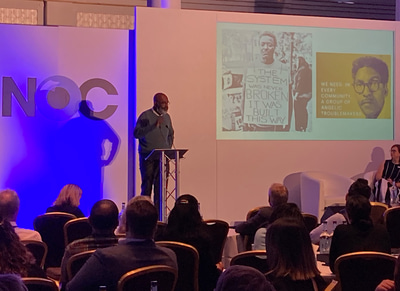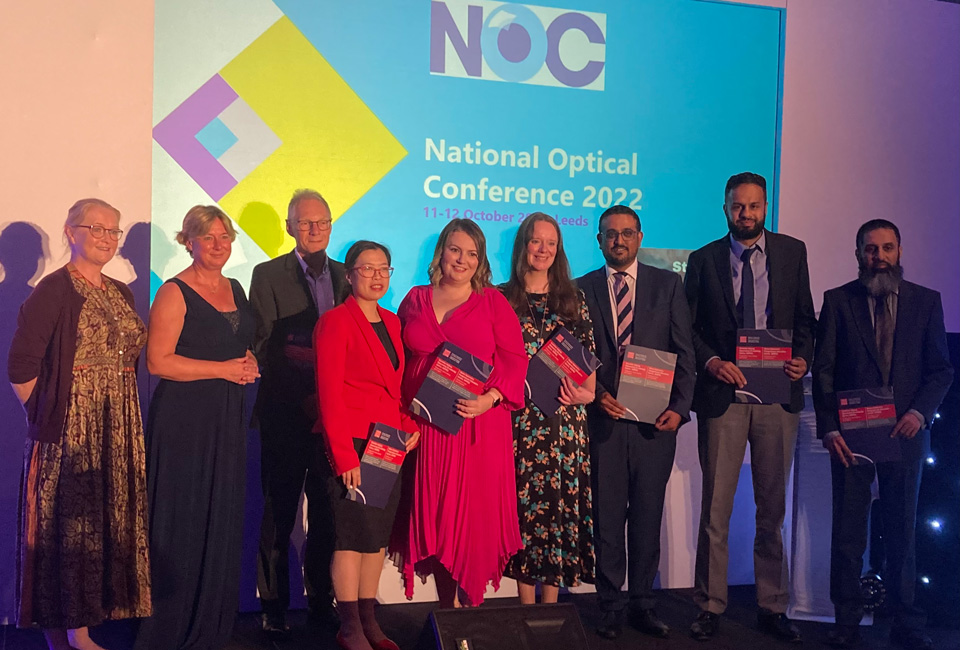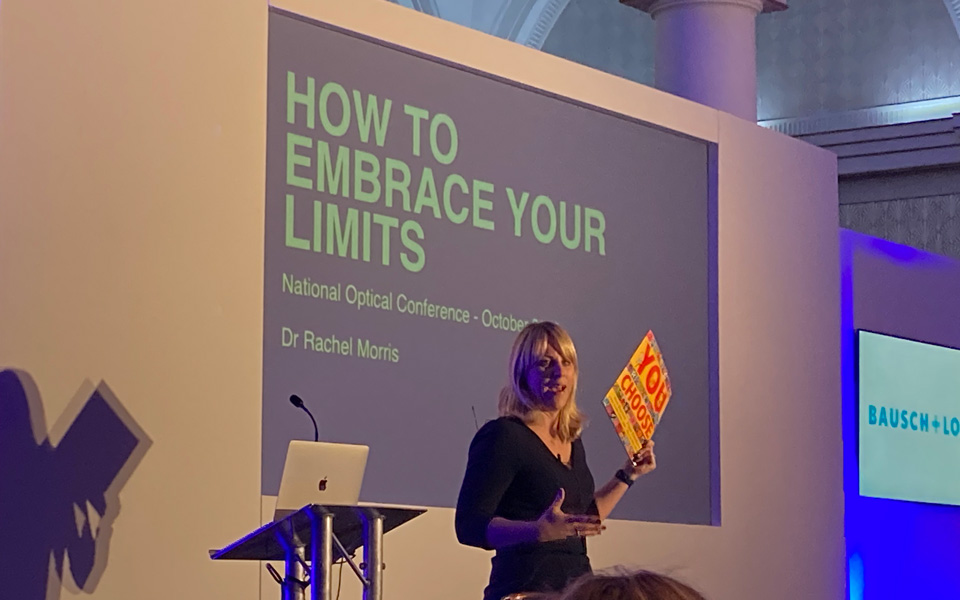- OT
- Professional support
- Optical organisations
- Five insights from the National Optical Conference
Five insights from the National Optical Conference
From work-life balance to transforming the way eye care is delivered, NOC delegates heard from a diverse range of speakers in Leeds

19 October 2022
The National Optical Conference was held at the Queen’s Hotel in Leeds last week (10 -– 12 October).
Alongside NHS reform and progress on Optometry First’s pioneering approach to delivering eye care, optical committee leaders heard presentations on addressing racial disparities within the health service and the importance of work-life balance.
An evening dinner on Tuesday saw Professor Barbara Ryan present certificates to the latest graduates from the Local Optical Committee Support Unit’s (LOCSU) Leadership Course for Optical Professionals.
OT presents a snapshot of discussions during the three-day event.
1 Professor Anton Emmanuel praised the influence of “angelic troublemakers” in his presentation on racial disparities within healthcare

“Be accountable for what you are responsible for,” he said.
Emmanuel described measures such as unconscious bias training as the “sprinkles on the cupcake.”
There are 300,000 black and Asian workers within the NHS, Emmanuel noted.
He shared that one of his personal heroes is Bayard Rustin, a prominent leader within the US civil rights movement, who said that in every community there should be a group of “angelic troublemakers.”
“Come into the room, but then rip it up,” Emmanuel said.
The NHS WRES has established a series of key regional and national indicators that assess progress towards racial equality within the NHS.
A 2020 report by NHS WRES found that 80% of white candidates were shortlisted for consultant posts, compared to 66% of black and minority ethnic (BME) candidates. When it comes to a job offer, 77% of white candidates received an offer, compared to 57% of BME candidates.
Come into the room, but then rip it up
BME doctors were twice as likely to be referred to the General Medical Council as white doctors.
Emmanuel shared that the same evidence-based principles that are used within healthcare can be applied to equality, diversity and inclusion.
“It’s not like we are asking you to turn back tides. This stuff is dead simple if you give a damn,” Emmanuel shared.
2 Optometry First initiative cuts paediatric eye care waiting list in half at Bassetlaw Hospital
Delegates to NOC received an update on how Optometry First is changing care within three early adopter regions – Isle of Wight, Bassetlaw and Sefton.
LOCSU clinical director, Zoe Richmond, highlighted that Optometry First is about encouraging optometrists and other optical professionals to practise at the top of their licence in order to improve patient care.
“The ambition is that the whole population should have access to eye care locally,” Richmond said.
Speaking about Bassetlaw, Carolyn Fox highlighted that COVID-19 was a catalyst for the NHS to address longstanding capacity issues.
“As hard as the pandemic was, it was a real enabler for change,” she observed.
She noted that 91% of presentations received through the COVID-19 Urgent Eyecare Service did not need to go to secondary care.

After performing an audit of the waiting list for paediatric care at Bassetlaw Hospital, half of patients were redirected to be seen within the community.
An audit of the adult waiting list for ophthalmology resulted in one in five patients being redirected to a community pathway.
Fox shared that there has been a 9% reduction in referrals to ophthalmology within Bassetlaw since July.
3 “Collaboration”: the key ask from the new national clinical director for eye care
Louisa Wickham and other panellists put forward their “key ask” from optometrists working in the community during a question and answer session at NOC.
The new national clinical director for eye care replied that there is a significant challenge ahead for those aiming to transform eye care.
“We need to work collaboratively, listen respectfully to the opinions of others and move forward together,” Wickham shared.
“We need to keep the door open for everyone and put to one side the competitive aspects that may have existed historically between the different groups that deliver eye care,” she said.
4 A former GP and executive coach shares her tips on work-life balance
“You are replaceable as a boss or as a worker,” guest speaker, Dr Rachel Morris, told NOC delegates.
“You are not replaceable as a mother, a daughter or an auntie,” she emphasised.
The former GP, executive coach and podcast host shared her guidance on prioritising wellbeing in busy workplaces – noting the significant effects of stress on health and performance.
The 2022 General Optical Council registrant survey revealed that close to one in ten optometrists and dispensing opticians (9%) had taken a leave of absence due to stress.
Morris emphasised the importance of establishing and enforcing boundaries to make time for activities that foster wellbeing.
“We need to start making decisions about what is important to us,” she said.
When assessing what activities to say no to, consideration should be given to the consequences of establishing boundaries.

Acceptable risks may be the fear of inconveniencing someone or missing out on a professional opportunity – while people may be more hesitant about refusing work where it could result in patient harm or job loss.
Morris noted that many anxieties centre around a future that has not yet occurred. She noted that the amygdala responds to perceived workplace risks in the same way as physical threats.
By making a small collective change we can contribute to changing systems. We can create a more inclusive society for all
“We experience a difficult email in the same way our ancestors’ brains would have responded to a lion that is about to eat us,” Morris said.
While people are not in control of this hardwired biological response, they can press pause after feeling the initial anxiety.
“If you can put a sliver of time between the trigger and the response you’ve got a better chance of reacting in a more rational way,” she said.
5 Making sure all voices are heard within local optical committees
During a workshop session delivered by optometrists Bobby Fida and Farah Awan, attendees discussed the importance of equality, diversity and inclusion (EDI) within the optical workforce.
“Diversity is recognising that people are different and that we all have different approaches to decision making. Inclusion is valuing those differences and creating a sense of belonging,” Awan explained.
Awan noted that many members of the group would have seen LOC members being overlooked during meetings or talked over.
“The key is to be proactive,” she emphasised.
“What happens is that when we are scared to challenge the status quo, we lose valuable members of our LOCs or they have a negative experience,” Awan noted.
“By making a small collective change we can contribute to changing systems. We can create a more inclusive society for all,” she highlighted.
The results of a survey of LOC members on EDI issues are scheduled to be published over the coming weeks.
Advertisement


Comments (0)
You must be logged in to join the discussion. Log in